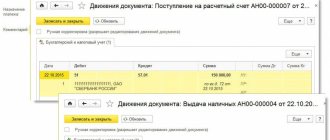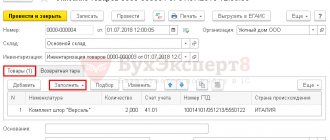What to show on account 71
Order of the Ministry of Finance of the Russian Federation No. 94n approved that account 71 “Settlements with accountable persons” is intended to reflect transactions for the issuance and return of accountable amounts.
What is a subreport? This is a certain amount of money from the organization that is transferred to the employee for specific purposes. Moreover, the purpose of expenses and the reporting period are strictly limited. After the allotted time has passed, the subordinate must provide a report on the expenses incurred. In simple words, money is given in advance, but with the condition that the employee provides a report - this is the essence of reporting.
For example, the company secretary was given 100 rubles from the cash register to buy an envelope and send a letter. When the reporting employee sends the letter, he will be given a receipt or check at the post office. It is these payment documents that the secretary will attach to the report, which will confirm the fact that the funds were spent on purpose.
For what purposes can a report be issued:
- Advance on travel expenses. This is relevant when an employee is sent on a business trip. Travel allowances include payment for accommodation and travel, daily allowances and other expenses en route.
- Expenses for the business needs of the company. Money can be issued for any purpose, from buying a light bulb for a utility room to building materials for major repairs.
- Settlements with counterparties. For example, the issuance of money is subject to payment for the services of third-party organizations. The operation is used less and less often, since non-cash payments are much more convenient.
- Other goals fixed by the decision of the company management. The director has the right to order the issuance of a report for any purpose. For example, for the purchase of equipment, exclusive rights, software products, etc.
IMPORTANT!
Loans and advances to employees cannot be reflected in account 71. For this purpose, a separate account is provided in accounting - 73. Some companies, wanting to simplify accounting and evade taxes, issue short-term loans to employees through 71 accounts. This is a violation.
Account purpose
Account 71 is intended to record the issuance and return of unspent accountable amounts. Money from the cash register is issued with the execution of an expense cash order and only on the condition that the employee has submitted an advance report on the spent accountable funds received earlier.
To receive funds, the employee writes an application, which must be certified by the head of the company. After the expiration of the period for which the funds were provided, the employee must provide reports within 3 days on the purpose and amount of money spent. Unspent funds are returned to the company's cash desk.
Rules for issuing money report
The organization is obliged to independently develop and approve the procedure for settlements with accountable persons. For example, by identifying uniform provisions in the annex to the accounting policies. The company calculates limits and standards on an individual basis.
Key requirements for conducting settlements with accountable persons:
- Money can only be given to an employee of the company. That is, accountable persons (account 71 is used only in this case) must be determined by a separate order of the manager.
- Funds can be transferred in cash from the cash register or by bank transfer. Which method will be used in settlements with accountable persons should be specified in the accounting policy.
- The maximum amount to be issued for reporting can be fixed by a separate order of management.
- It is recommended to approve the limits on travel expenses in the subsistence report separately.
- The deadline for submitting a report on accountable money is also fixed in the regulations or in the accounting policy.
- All settlements with accountable persons (account 71) must be documented. To do this, checks, invoices, tickets, receipts and other documentation are attached to the report.
Money is issued based on a written application from the employee or by order of management. The recipient is required to sign the cash receipt order if funds are issued in cash from the cash register. When making purchases or while on a business trip, the reporting employee must keep all receipts and checks in order to account for the advance received. Upon returning from a trip or upon completion of the purchase, the subordinate draws up an advance report. Supporting documents are attached to the report. The deadline for drawing up a report on accountable money is 3 days.
Calculations of the employer and employee according to the report: postings
While on a business trip, a person can:
- spend exactly the amount issued by the employer;
- spend less;
- spend more (paying extra at your own expense).
In the first case, accounting is limited to the recognition of expenses - according to the schemes discussed above. In the second and third cases, the employer withholds or compensates funds.
As a rule, after a business trip, it is the employee who owes something: employers try to issue accountable money with a reserve. It returns the excess:
- depositing funds through the cash register;
- by depositing the remaining amount into his current account;
- agreeing to deduct wages to pay off the debt (if the amount was not returned to them on time).
Example 4
Ivanov A.S. went on 3 business trips.
To complete the first, he received accountable money in the amount of 10,000 rubles. (Dt 71 Kt 50 (10,000)). Spent 7,000 rubles on the purchase of goods for the employer’s needs. (Dt 41 Kt 71 (7 000)). Then he returned the balance to the organization’s cash desk (Dt 50 Kt 71 (3,000)).
For his second business trip, he received the same amount and purchased similar goods. But he returned the excess by crediting the money to the organization’s current account (Dt 51 Kt 71 (3,000)).
On his third business trip, Ivanov received and spent the same amount on goods. But at the same time, he did not return the balance of unspent funds on time and agreed that the employer withhold the debt from wages.
Then accounting:
- writes off the amount not returned by the employee as shortages: Dt 94 Kt 71 (3,000);
- reflects deduction from salary: Dt 70 Kt 94 (3,000).
It happens that an employee, without paying the employer, quits - and he is left with a debt. In certain cases, the employer may not be able to recover it. For example, if the only way to do this is to file a lawsuit, and the employer missed the statute of limitations.
Example 5
Ivanov A.S., having failed to pay his employer for an unrepaid accountable debt, quits his job. Let us agree that the employer has lost the right to collect the debt.
Then accounting:
- in case of delay in repayment of the amount, the debt is included in the shortfall: Dt 94 Kt 71 (3,000);
- upon dismissal of an employee - transfers the debt to settlements with debtors and creditors: Dt 76 Kt 94 (3,000);
- if the right to collect the debt is lost, it is written off as other expenses: Dt 91.2 Kt 76 (3,000).
It happens that an employee, having spent the accountable amount, is forced to pay extra for travel expenses from his own pocket. The employer is obliged to reimburse the expenses.
Example 6
Ivanov A.S., while on a business trip, spent 3,000 rubles issued by the employer, and another 2,000 rubles. theirs. The employer recognized his expenses as justified and agrees to compensate them.
The accounting department will record:
- an advance was issued for the report: Dt 71 Kt 50 (3,000);
- expenses for the advance report are included in production: Dt 20 Kt 71 (5,000);
- Ivanov was given compensation from the cash register: Dt 71 Kt 50 (2,000).
With non-cash compensation, the posting will be as follows: Dt 71 Kt 51 (2,000).
An unpleasant scenario for the employee is also possible - when the company remains in debt, but it cannot pay off (due to bankruptcy). The amount of the outstanding debt in this case is included in other income: Dt 71 Kt 91.1.
Calculations for accountable amounts may involve the participation of not only the employer and employee, but also more parties. For example, when an employee is instructed to pay a counterparty in cash for a future delivery (or vice versa - for previously received goods).
Example 7
Ivanov A.S. was instructed to pay for the delivered goods in cash, giving 60,000 rubles. to pay the supplier. The employer and his counterparty-supplier are VAT payers.
Accounting of the employer who received the goods:
- reflects the existence of obligations to the counterparty - in the amount corresponding to the cost of the goods without VAT: Dt 41 Kt 60 (50,000);
- reflects VAT on the product: Dt 19 Kt 60 (10,000);
- accepts VAT for deduction: Dt 68 (sub-account “VAT”) Kt 19 (10,000);
- reflects the issuance of the accountable amount to Ivanov: Dt 71 Kt 50 (60,000);
- reflects the fact of payment by Ivanov for the delivery of goods: Dt 60 Kt 71 (60,000).
If we talk about cases when the employer still owes something to the employee on an accountable basis, we can consider the obligations associated with the appearance of exchange rate differences, if the accountable amount is in foreign currency.
Example 8
Let us remember Ivanov, who went to Germany. He has 1,000 euros from his employer and he spends it. Let's imagine that he spends another 200 euros from himself, which the employer compensates for him.
Central Bank of the Russian Federation rates:
- on the day of issuing an advance in foreign currency before a business trip - 72 rubles;
- on the day of execution of the advance report - 73 rubles;
- on the day of issuance of compensation according to the advance report - 74 rubles.
The accounting department will record:
Dt 71 Kt 50 - issued for reporting 1000 euros at the rate of 72 rubles. (72,000);
Dt 44 Kt 71 - expenses on the advance report are reflected at 1,200 euros at the rate of 73 rubles. (87,600);
Dt 71 Kt 50 - 200 euros were issued from the cash register to the employee at the rate of 74 rubles. (14,800);
Dt 71 Kt 91.1 - the exchange rate difference is determined to be 800 rubles.
Characteristics of account 71
71 accounting accounts are considered active-passive accounts. This means that account balances can have both a debit and a credit balance at the end of the reporting period. This means that at the end of the month the debt may be registered with the employee. For example, a subordinate has just received an advance and has not yet had time to report.
The debt may also be attributed to the company. For example, if an employee spent his own funds to provide for business needs or on a business trip. Overexpenditure is reflected in accounting after the employee has provided an advance report and documented his expenses.
Definition
Account 71 is one of the most widely used in accounting transactions. Quotes from account 71, which is called “Settlements with accountable persons” or “Calculation of accountable amounts,” are used to reflect data on funds issued from the cash register and received by an employee of a business entity.
The tasks of issuing money to an employee are as follows:
- implementation of economic and operational activities;
- carrying out small wholesale purchases of goods;
- provision of travel and hospitality expenses.
In most cases, the need to issue financial resources arises when an employee completes tasks assigned by management to carry out the direct activities of the organization.
The peculiarity of the essence of account 71 is that the issued amount does not become the property of the accountable person and has a strictly intended purpose.
That is, an employee of an enterprise has the right to spend money only on the goals set by the manager, and also if they are a production necessity. If there is a balance of the amount received for reporting, it is returned to the cashier.
An important point is compliance with cash discipline regarding operating cash. After the employee has fully completed the assigned task, it is necessary to provide a full report on the expenditure of the funds received within three working days.
Otherwise, if for some reason the deadlines for submission are missed or the report is not provided at all, such amounts are regarded by the modern Tax Code of the Russian Federation as income of an individual and are subject to taxation in conjunction with other income of the employee in accordance with Art. 137 Labor Code of the Russian Federation. Retention of unused and unreturned funds is carried out on the basis of Art. 138 of the Labor Code of the Russian Federation after submitting a written application and within the limits of up to 20% of wages.
The modern regulatory framework of Russia does not regulate the period for issuing accountable funds; these points are stipulated by the internal documents of the organization. As accountable amounts, money can be issued exclusively to employees of the enterprise.
Debit and credit of account 71: what to reflect
| What we reflect on the debit of account 71 | What do we indicate in the credit of accounting account 71 |
| 71 debit account is the amount that was provided to the company employee in advance for specific expenses. That is, this is the money that the employee received as an account. For example, a cashier dispenses cash from a cash register. The balance of account 50 “Cash” decreases - the turnover to the credit account is reflected. 50. And at the same time the debit turnover on the account is reflected. 71 - the employee received accountable funds. Before the subordinate provides an advance report, he will be credited with an advance - a debit balance on the account. 71. Or a debit balance is formed if the employee reported less than the amount received in advance. The remainder should be returned to the organization's cash desk. | In the credit of the account we reflect the expenses of the accountable person, supported by documents. That is, the employee submitted an advance report, and the manager checked and approved it. Then the accountant accepts the transactions for accounting and accrues expenses according to the report. The expenditure of funds is reflected in the credit of accounting account 71. At the same time, the debit balance of the account decreases. The result of the operation may be the loan balance if the reporting employee spent his money on company expenses. The company must repay this debt. That is, pay the amount of the credit balance to the accountable person. |
Postings for payment of travel allowances
The issuance of travel allowances to an employee is accompanied by accounting entries and execution of relevant documents. Having paid funds from the cash register to the account, the following entry is made: Dt account 71 Kt account 50. If the money was transferred to a corporate payment card, the operation is recorded with the entries: Dt 55 Kt 51, Dt 71 Kt 55.
The further accounting procedure depends on the purpose for which the employee was sent on a business trip. If production needs are fulfilled, accounts 20, 23 or 29 are debited with account 71. Travel of an administrative and managerial nature is written off to account 26, for the sale of goods - to account 44.
A business trip associated with the acquisition of property for an enterprise is included in the cost of the purchased asset and is reflected in the corresponding account for inventory, non-current assets, and goods.
The amount of VAT on travel payments of a production nature is taken into account by the following entries:
- Dt “VAT” Ct “Calculations for accountable amounts” – the VAT amount is accepted for accounting.
- Dt 68 “Calculations for taxes” Kt 19 “VAT” - tax deduction of VAT was carried out.
It should be remembered that VAT is not deducted for expenses not related to production. A posting is made: Dt “Other expenses” Kt “VAT”, meaning VAT is written off.
Confirmed expenditure of travel funds for a large amount is subject to reimbursement by the enterprise in favor of the employee, posting - Dt account 71 Kt account 50. If the employee returns unspent amounts, the operation has the opposite form: Dt “Cash” Kt “Calculations for accountable amounts”.
Accounting entries for account 71
Let's look at how to correctly make transactions for 71 accounts. Here are typical transactions and correspondence of accounts. Let us indicate which documents to draw up during the operation.
| Operation | Debit | Credit | Foundation documents |
| Money issued in cash report | 71 | 50 | A cashier's report and an expense order were drawn up |
| Funds are credited to the bank card account | 71 | 51 | Bank statement, payment order for transfer |
| Funds are credited to the report on the organization’s corporate card | 71 | 55 | Bank statement from special company accounts |
| The purchase of fixed assets is reflected in the advance report | 08 | 71 | Certificate of acceptance of works and services |
| Materials and raw materials purchased by the accountable person were capitalized | 10 | 71 | Invoices, sales receipts, transportation documents, acceptance certificate |
| The amount of expenses according to the advance report for production and economic needs is reflected | 20, 26, 44 | 71 | Advance report, invoices |
| Return to the cash desk of funds unspent by the accountable person | 50 | 71 | Cashier's report, receipt order |
| Debt accrued for amounts not returned on time by the accountable person | 73 | 71 | Advance report |
Now let's look at examples of posting entries for various situations.
An example of filling out a balance sheet
As of 04/01/2020, the accountable Simonov S. has an overexpenditure of one amount received under the report in the amount of 1000 rubles. and debt on the second in the amount of 5,000 rubles. The deadline for the report has not yet arrived. The amounts are reflected in the opening balances.
In the second quarter, S. Simonov received 1,000 rubles from the cash register. (debit turnover) and compiled an advance report for the second amount in the amount of 4,500 rubles. (credit turnover).
After this, another accountable Vasiliev A. received an amount for household needs - 2800 rubles. (debit turnover).
Now the ending balance in the statement will look like:
Simonov S. - final debit balance: 500 rub.
Vasiliev A. - final debit balance: 2800 rub.
The company records settlements with accountants using subaccount 71.01 “Settlements with accountants in rubles.”
Note! An employee can receive a new sum of money against the report before the previous one is fully settled.
Example No. 1. Overspending - debt in favor of an accountable employee
Vesna LLC issued in June to secretary P.P. Karandashikov. 3000 rubles for the purchase of pencils. The funds were issued from the cash register. The employee made a purchase in the amount of 3,150 rubles. An advance report was drawn up on the costs incurred, a fiscal receipt and a delivery note were attached to the documents.
Postings:
| Operation | Debit | Credit | Amount, rub. |
| The report was issued from the cash register | 71 | 50 | 3000 |
| The advance report has been approved, the expenses for the purchase of pencils have been taken into account | 10 | 71 | 3150 |
| The overspending was transferred to the secretary's bank card | 71 | 51 | 150 |
Correspondence with other accounts
Account 71 is debited when money is issued to the employee on account. For this purpose, they mainly use account 50 if the money was issued from the cash register, and account 51 if the funds were transferred from the current account.
Account 71 is credited with the following accounting accounts:
- non-current assets;
- production process inventories;
- production process costs;
- goods and products;
- funds in cash equivalent;
- settlements with employees and other transactions;
- financial result.
Accounts I–IV of sections of the standard chart of accounts are used in correspondence with the credit of account 71 in the case of issuing accountable amounts for the purchase of materials, inventories and other material assets related to the non-current assets of the organization or the production and sales process.
Accountable amounts not paid on time are written off to the financial result of the enterprise (“Shortages and losses”). In the future, the accountant can reflect the amount of the employee’s debt to the organization in account 70 and write it off from the salary.
Example No. 2. The balance is the debt of the accountable person
To purchase a laptop for Vesna LLC specialist K.K. Barankin. 35,000 rubles were transferred to the card. A computer hardware store provided Barankin with a 10% discount on the cost of the laptop (3,500 rubles). The total purchase amounted to 31,500 rubles. Barankin provided an advance report and returned the balance to the cashier.
Postings:
| Operation | Debit | Credit | Amount, rub. |
| The sub-report is listed on the Barankin map | 71 | 51 | 35 000 |
| The advance report has been approved, the expenses for the purchase of a laptop have been taken into account | 08 | 71 | 31 150 |
| The balance was returned to the cash desk of Vesna LLC | 50 | 71 | 3500 |
Reflection of entertainment expenses in accounting
To account for the issued accountable amounts for the purpose of paying for entertainment events, entries are made for 71 accounts:
- DT “Calculations for accountable amounts” CT “Cash” - money was issued for reporting.
- DT “General business expenses” CT “Calculations for accountable amounts” – reflects the amount of entertainment expenses.
- Dt “VAT” Ct “Calculations for accountable amounts” – the amount of VAT is taken into account.
- Dt "Cash" Kt "Settlements for imprest amounts" - unused funds are returned to the enterprise's cash desk.
- DT “Calculations for accountable amounts” CT “Cash” - funds were issued as compensation to the employee for overexpenditure.
- DT “Retained profit/loss” DT “Calculations for taxes” - in case of excess of standardized expenses, the amount of VAT on the overexpenditure is restored.
The amount of entertainment expenses should not exceed 4% of labor costs in the reporting period.
Characteristic
The information content of the account defines this account as a register of material accounting of funds. The Order “On the Accounting Policy of an Enterprise” regulates the specifics of maintaining account 71 - on the active or passive side.
- Credit balance. The occasional use of small-scale reporting in enterprises with modest turnover allows you to pay expenses after they have been incurred.
- The balance is debit. Management chooses a policy of advance payment. Advance payment is the most convenient option for enterprises where frequent, long-term business trips or constant large-scale purchases for cash are practiced.
For each accountant, the enterprise maintains detailed analytical records in the context of 71 accounts. If analytical accounting records specific turnover for each individual employee, then thanks to synthetic accounting the total amount of turnover is reflected, balances characterizing the relationship between personnel and the organization in the area of production expenses.










